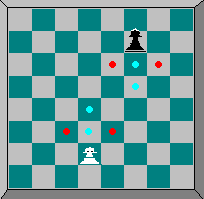 |
 E-mail E-mail | There are eight pawns situated on each side of the board. They are the least powerful piece on the chess board, but have the potential to become equal to the most powerful. Pawns cannot move backward or sideways, but must move straight ahead unless they are taking another piece.
Should a pawn get all the way across the board to reach the opponent's edge of the table, it will be promoted. The pawn may now become any piece that the moving player desires (except a king or pawn). Thus a player may end up having more than one queen on the board. Under normal circumstances a player will want to promote his pawn to be a queen since that piece is the most powerful and flexible. The new piece is placed where the pawn ended its movement. There is a separate rule regarding pawns called en passant that will be described separately.
 Go To Next Page Go To Next Page
|
|
